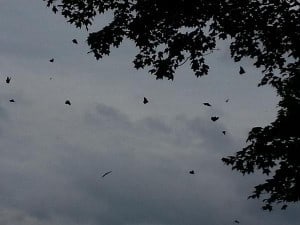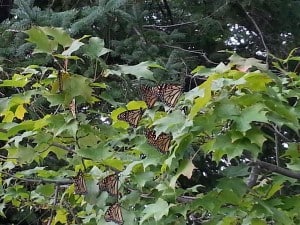At 10:30 am on Sept. 19, we had 100 or so Monarchs congregating (roosting) in trees in our front yard at our farm on Chemong Road. I’ve never seen one on our farm before. My husband had gone down our laneway and drove through the swarm, and called me from the end of the driveway to tell me about them. The wind seemed to be kicking up quite a bit at the time, so I wondered if they were taking shelter. Another group landed in the spruce tree beside the maple. I took pics of the Monarchs that were lower on the trees, as some were too high that I didn’t figure the picturtes would turn out.
Jen Sanderson, Chemong Road
Background (source: Journey North): Monarch butterflies only migrate during the day. They come down at night and gather in clusters called roosts. Roosts begin to form in mid-August. Some roosts have only a handful of butterflies. Some roosts have too many butterflies to count! Most last for only a night or two. Much of what is known about monarch roosts is based on the observations made by citizen scientists. They seem to form close to good nectar sources. Scientists still have many questions about roosting behavior. Dr. Lincoln Brower has studied monarchs for over 50 years. He knows that roosting must be critical for monarch survival. “If I discovered a roost, I’d pull up a chair, grab a pair of binoculars and just sit and watch! I’d try to stay hour after hour, day after day — as long as the monarchs were there. People can contribute important observations by going with an open mind and documenting what they see.”

